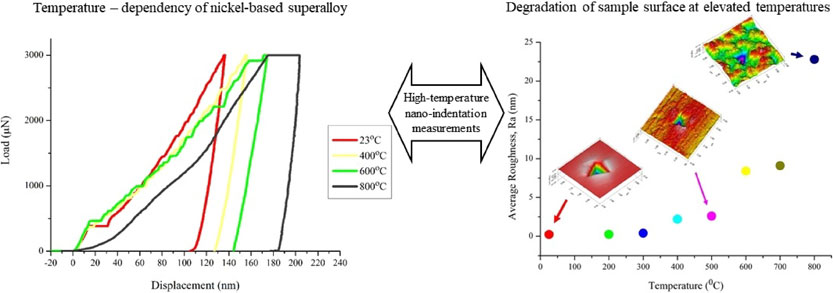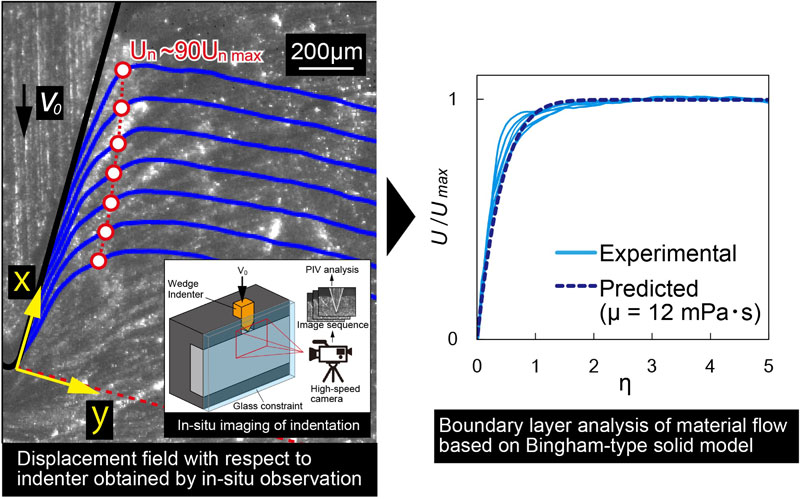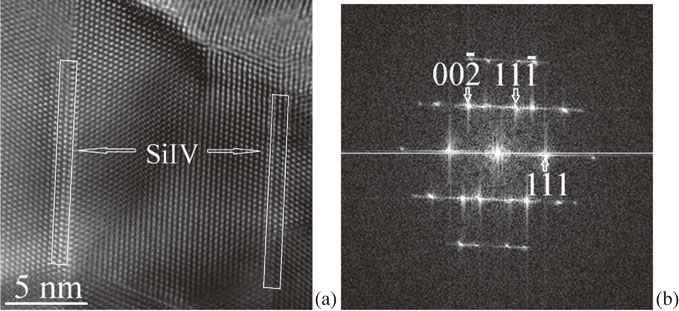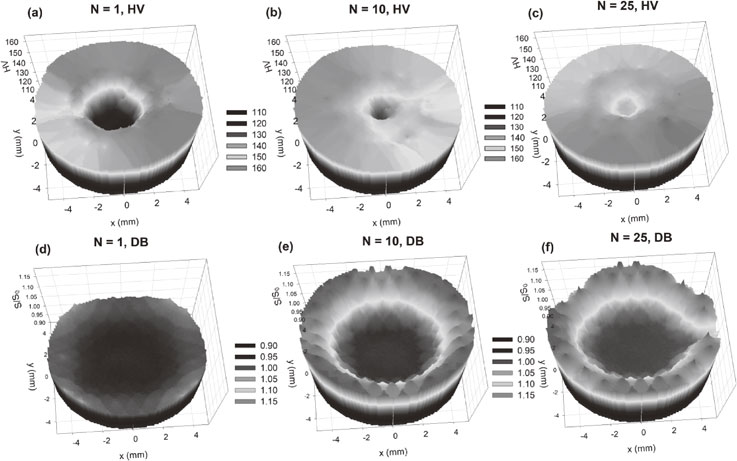-
Takahito Ohmura, Nobuaki Sekido
Article type: Preface
Subject area: Special Issue on Recent Advances in Indentation Technique
2019Volume 60Issue 8 Pages
1403
Published: August 01, 2019
Released on J-STAGE: July 25, 2019
JOURNAL
FREE ACCESS
FULL-TEXT HTML
-
M. Munawar Chaudhri
Article type: Review
Subject area: Special Issue on Recent Advances in Indentation Technique
2019Volume 60Issue 8 Pages
1404-1410
Published: July 01, 2019
Released on J-STAGE: July 25, 2019
Advance online publication: April 12, 2019
JOURNAL
FREE ACCESS
FULL-TEXT HTML
This review confirms that the Love equation which connects the load on a rigid cone loaded normally on an elastic half-space, and its penetration into the half space, has been verified by several theoreticians. Furthermore, the predictions of the Love equation have been experimentally validated. It is argued here that a modification of the Love equation made about 20 years ago is incompatible with several theoretical treatments as well as with the expression for radial surface particle displacement outside the contact. Moreover, it is also shown that normal loading behaviour of a rigid cone on an elastic half-space cannot be likened to that of the normal loading behaviour of a rigid three-sided or a four-sided pyramid. Lastly, corrections are made to some important expressions given in a well cited paper by Sneddon (1965).

In situ photograph of the surface profile when a 90° included angle tungsten carbide cone is loaded on a block of PDMS (1:10). The surface profile, shown below, is well fitted by eq. (3). (Adapted from Ref. 13). (Reprinted by permission of Taylor & Francis Ltd, http://www.tandfonline.com)
Fullsize Image
View full abstract
-
Jovana Ruzic, Ikumu Watanabe, Kenta Goto, Takahito Ohmura
Article type: Regular Article
Subject area: Special Issue on Recent Advances in Indentation Technique
2019Volume 60Issue 8 Pages
1411-1415
Published: August 01, 2019
Released on J-STAGE: July 25, 2019
JOURNAL
FREE ACCESS
FULL-TEXT HTML
A new approach of nano-indentation measurements at elevated temperatures has been developed to evaluate a temperature-dependent mechanical behavior of heat resistant alloys on a submicron scale, where the measurement is conducted in an inert atmosphere to prevent the surface oxidation of a sample and heat an indenter passively. The developed approach enables us to perform nano-indentation testing with a diamond indenter in the temperature range of 23∼800°C. The developed approach has been applied to gamma single-phase single-crystal of a nickel-based superalloy. Then the degradations of the sample surface and the indenter tip have been discussed in this case.
View full abstract
-
Takahiro Mineta, Seiji Miura, Kazuhiko Oka, Tatsuya Miyajima
Article type: Regular Article
Subject area: Special Issue on Recent Advances in Indentation Technique
2019Volume 60Issue 8 Pages
1416-1422
Published: July 01, 2019
Released on J-STAGE: July 25, 2019
Advance online publication: March 08, 2019
JOURNAL
FREE ACCESS
FULL-TEXT HTML
In the present study, a newly established in situ indentation technique by the use of an optically transparent indenter and an immersion liquid, so-called “modified optical indentation microscopy”, was applied for an investigation on the plastic deformation behavior of various samples during indentation. In this technique, the gap between the indenter and the specimen surface is filled with the immersion liquid such as silicone oil and kerosene to widely observe the specimen surface during indentation. In the in situ observations by this technique using polycrystalline pure Mg, the occurrence of various plastic deformation mechanisms and the increase of the anisotropic contact area during indentation can be recognized. Moreover, the increase and the decrease of the contact area which is corresponding to superelasticity during indentation were observed by this technique using the TiNi superelastic alloy. The results of the in situ observations were consistent with the analysis results based on the Hertz theory.

Fig. 3 (a–f)
In situ images, (g) an optical micrograph after testing, and (h) EBSD analysis results of polycrystalline pure Mg. The red circles in (b) indicate the twins.
Fullsize Image
View full abstract
-
Keisuke Asai, Satoshi Yoshida, Akihiro Yamada, Jun Matsuoka, Andrei Er ...
Article type: Regular Article
Subject area: Special Issue on Recent Advances in Indentation Technique
2019Volume 60Issue 8 Pages
1423-1427
Published: July 01, 2019
Released on J-STAGE: July 25, 2019
Advance online publication: January 25, 2019
JOURNAL
FREE ACCESS
FULL-TEXT HTML
In this study, micro-photoelastic measurements were performed to obtain three-dimensional stress maps of silica and soda-lime glasses during ball indentation. The stress components were calculated from retardations and azimuths, which were determined from photoelastic measurements with a spatial resolution of about 1 µm. During loading, it was observed that the tensile stress in the radial direction is generated near the surfaces of both glasses. During unloading, however, it was found that stress distributions of silica and soda-lime glasses are different from each other. It is concluded that the different stress distributions during indentation result in different crack geometries, ring and radial cracks.
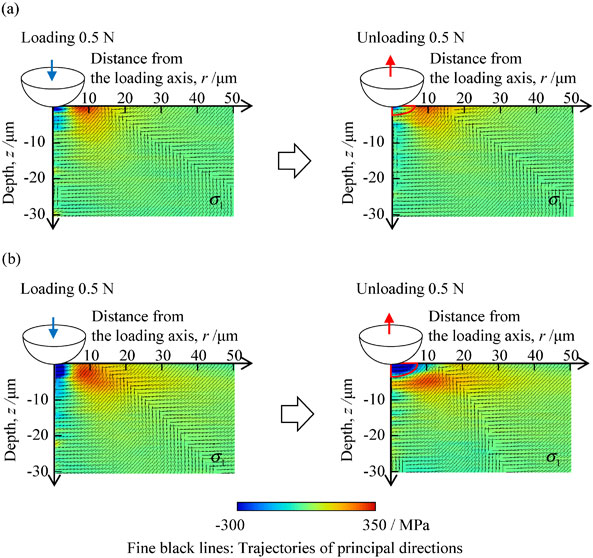
Fig. 4 Principal stress maps of (a) silica and (b) soda-lime glasses under a ball indenter. The origin of each stress map corresponds to the contact point between the indenter and the glass. The positive values (red) and negative values (blue) indicate tensile and compressive stresses, respectively. Fine black lines denote directions of principal stresses.
Fullsize Image
View full abstract
-
Satoshi Yoshida, Thu Huyen Nguyen, Akihiro Yamada, Jun Matsuoka
Article type: Regular Article
Subject area: Special Issue on Recent Advances in Indentation Technique
2019Volume 60Issue 8 Pages
1428-1432
Published: June 01, 2019
Released on J-STAGE: July 25, 2019
Advance online publication: November 16, 2018
JOURNAL
FREE ACCESS
FULL-TEXT HTML
In-situ structural changes of glass under a sharp diamond indenter are evaluated by using a micro-Raman spectrophotometer coupled with a self-made indentation equipment. This set-up enables us to obtain in-situ Raman spectra of glass under a Vickers indenter and to observe transient and permanent structural changes in glass. It is found that in-situ Raman spectra of silica glass under the Vickers indenter show distinct peak-broadening, which is not observed in the in-situ Raman spectra of hydrostatically compressed silica glass, nor in those of soda-lime silicate glass. This suggests that the indentation-induced shear stress causes the glass structure to be deformed into a different one with a wider bond angle distribution. Such a shear-induced structural change could play a key role on the contact damage of glass, especially for glass with a high degree of polymerization, like silica glass.
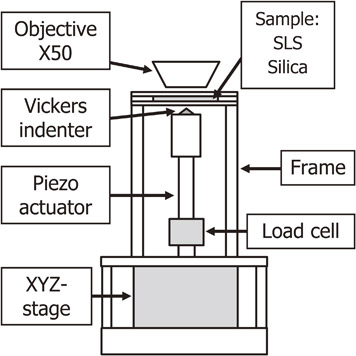
Fig. 1 Schematic illustration of a self-made indenter for
in-situ Raman spectroscopy. The object lens is mounted on the commercial Raman spectrophotometer.
Fullsize Image
View full abstract
-
Igor I. Maslenikov, Vladimir N. Reshetov, Alexey S. Useinov
Article type: Regular Article
Subject area: Special Issue on Recent Advances in Indentation Technique
2019Volume 60Issue 8 Pages
1433-1435
Published: July 01, 2019
Released on J-STAGE: July 25, 2019
Advance online publication: January 11, 2019
JOURNAL
FREE ACCESS
FULL-TEXT HTML
The transparent indenter which can used as an optical objective were tested to obtained a spectra during the indentation. A special device which comprises the transparent indenter and actuator was developed and embedded into the Raman spectrometer. An indentation into the silicon sample was performed and phases that exist under the load and without it were identified.
Fig. 4 Raman spectra obtain during and after the unloading part of the indentation.
Fullsize Image
View full abstract
-
Tatsuya Sugihara, Anirudh Udupa, Koushik Viswanathan
Article type: Regular Article
Subject area: Special Issue on Recent Advances in Indentation Technique
2019Volume 60Issue 8 Pages
1436-1441
Published: July 01, 2019
Released on J-STAGE: July 25, 2019
Advance online publication: March 15, 2019
JOURNAL
FREE ACCESS
FULL-TEXT HTML
We study plastic flow in the vicinity of an indenter-material interface in wedge indentation of aluminum using high speed in situ imaging and particle image velocimetry (PIV) analysis. Displacement and strain fields in the indentation zone are obtained at high-resolution for different indenter angles and two lubrication conditions. These fields can be used to demarcate essential features of the material flow phenomena. The deformed layers close to the indenter wall fit a classical boundary layer profile in the framework of a Bingham-solid. Equivalent Bingham viscosities and boundary layer scaling relations are obtained. The viscosity values appear to reflect the nature of the friction interaction at the indenter-material interface and can potentially be used as a discriminating parameter for evaluating contributions to deformation and dissipation arising from interface friction.
View full abstract
-
Anirudh Udupa, Narayan Sundaram, Tatsuya Sugihara, Srinivasan Chandras ...
Article type: Regular Article
Subject area: Special Issue on Recent Advances in Indentation Technique
2019Volume 60Issue 8 Pages
1442-1449
Published: August 01, 2019
Released on J-STAGE: July 25, 2019
JOURNAL
FREE ACCESS
FULL-TEXT HTML
We study deformation patterns in wedge indentation of annealed metals (e.g., copper) using high-resolution, in situ imaging and image correlation. Based on attributes of the deformation such as velocity fields, grid distortion and strain distributions, we discriminate between two modes of deformation — a cutting mode with narrow-angle (sharp) wedges, e.g., apex angle of 30°, and a radial-compression mode with wide-angle (blunt) wedges, e.g. apex angle of 120°. The cutting mode is characterized by significant material flow parallel to the wedge face; and a thin region of very high strain (∼3), that is located immediately adjacent to the indenter face (wall-layer), and arises from friction-induced deformation. The radial-compression mode is distinguished by material flow normal to and away from the indenter face, with negligible velocity component parallel to the indenter face. The corresponding strain field is one of bulk deformation, with the highly-strained region (strain ∼1) being of semicircular shape that extends from near the edge of indenter contact at the specimen surface, to well below the indenter tip. The observations show that indenter wall friction is likely to have a major influence on the deformation field only with narrow-angle indenters.
Based on the observations of material flow, a suggestion is made (and validated) as to how the challenges faced in computational modeling of narrow-angle wedge indentation can be overcome. Implications for use of narrow-angle wedge indentation to study tribology of metalworking contacts, and ductile failure and damage in metals, are briefly discussed.
Fig. 5 Grid deformation and background velocity fields for indentation with (a) 30°, (b) 90° and (c) 120° wedges. Prior to the indentation, each grid was rectangular. A, B and C indicate the positions of select points on the grid that were located initially close to the specimen surface and just below the indenter tip. A′, B′ and C′ are the locations of these points after the indentation.
Fullsize Image
View full abstract
-
Renato Pero, Giovanni Maizza, Frediano De Marco, Piero De Fazio, Rober ...
Article type: Regular Article
Subject area: Special Issue on Recent Advances in Indentation Technique
2019Volume 60Issue 8 Pages
1450-1456
Published: August 01, 2019
Released on J-STAGE: July 25, 2019
JOURNAL
FREE ACCESS
FULL-TEXT HTML
A new dual-scale instrumented indentation test (DualS-IIT) methodology is here proposed to determine the yield stress (in a tensile-like sense). The methodology involves measuring the bulk yield radius, as defined by the expansion cavity model (ECM), induced by a Vickers macro-indentation in a medium plane cross-section. The bulk yield radius is measured by means of a subsurface nano-hardness survey along the load direction in correspondence to the transition interface between the hemispherical strain hardened region and the surrounding elastic region. The methodology has been applied to an Al–Li (A2198-T3) alloy and a yield stress of 297 MPa has been measured (in agreement with a tensile test); moreover, anomalous plastic deformation behaviour has appeared under indentation. The combination of macro- and nano-indentation tests in one single experiment, as in the proposed methodology, offers a unique experimental basis to directly correlate the mechanical properties of a material at two different scales, which at present is an open issue in the research on indentation.

View full abstract
-
Satyam Suwas, Soumita Mondal
Article type: Review
Subject area: Special Issue on Severe Plastic Deformation for Nanomaterials with Advanced Functionality
2019Volume 60Issue 8 Pages
1457-1471
Published: August 01, 2019
Released on J-STAGE: July 25, 2019
Advance online publication: June 21, 2019
JOURNAL
FREE ACCESS
FULL-TEXT HTML
Severe plastic deformation processes involve large grain rotations due to the action of different modes of plastic deformation and other microstructural changes which lead to characteristic texture formation. The present review deals with the evolution of texture during the most important severe plastic deformation processes, namely Equal Channel Angular Pressing (ECAP), High Pressure Torsion (HPT), Friction Stir Processing (FSP), Accumulative Roll Bonding (ARB) and Multi-Axial Forging (MAF). First three of the processes are shear based, while the latter two are plane-strain based. The textures formed during ECAP are visually different from simple shear textures due to (i) the inclination of the shear plane, (ii) additional contribution of non-shear based deformation. The relative intensities of texture components are function of deformation micro-mechanisms, amount of straining and configuration of the strain path. The texture evolved during HPT is very similar to simple shear texture, with additional consequences of microstructural changes that occur due to very large deformations. The textures formed in FSP process also resemble shear textures. On the other hand, texture evolution during ARB and MAF can be described using plane strain deformation. The present review deals with texture evolution during severe plastic deformation as a function of nature of processes and type of materials.
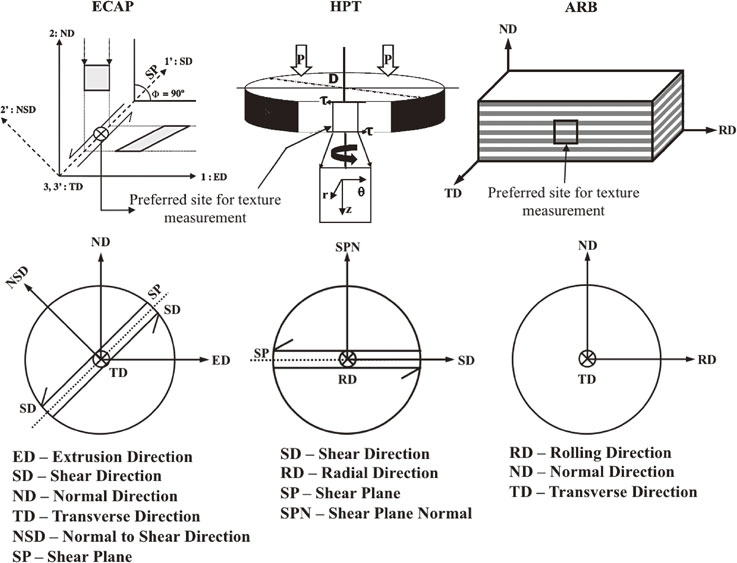
View full abstract
-
Masaki Mito, Shun Shigeoka, Hirotaka Kondo, Nozomi Noumi, Yuichiro Kit ...
Article type: Overview
Subject area: Special Issue on Severe Plastic Deformation for Nanomaterials with Advanced Functionality
2019Volume 60Issue 8 Pages
1472-1483
Published: August 01, 2019
Released on J-STAGE: July 25, 2019
Advance online publication: June 28, 2019
JOURNAL
FREE ACCESS
FULL-TEXT HTML
In fifth-group element superconductors V, Nb, and Ta, the increase in superconducting transition temperature (Tc) was attempted by using both high-pressure torsion (HPT) and additional hydrostatic pressure (HP) compression. The former brings about the grain refinement and strain accumulation in the unit-cell level. The additional compression for severely strained superconductors triggers strengthening intergrain-contact and/or structural deformation in the unit-cell level. The manner of the appearance of the above two effects depends on the kind of elements: First, in V, there is no prominent effect of HPT, comparing to the hydrostatic compression effects on its non-strained material. Next, in Ta, the effect of strengthening intergrain-contact appears at small hydrostatic compression, resulting in temporal increase in Tc. Finally, Nb exhibits prominent increase in Tc by both effects and, in particular, the structural deformation in the unit-cell level promotes the increase in Tc. Thus, the accumulation of residual strain in the level of starting material can be a promising work to manipulate Tc under HP compression.

Fig. 2 Strategy of the present study in the case of Nb.
33) (a) In high-pressure torsion (HPT) for controlling the initial condition, pressurization and revolution are conducted by using two metal anvils. As the revolution number (
N) increases, dislocations are accumulated (a-1), and the grain size largely changes. The small-angle grain boundaries gradually transform to large-angle grain boundaries with increasing
N ((a-2) → (a-3)). Finally due to the balance between generation and annihilation of dislocations, the grain size remains unchanged despite the increase in
N. (b) A few pieces of sample cut from the HPT-processed V, Nb, and Ta are placed in diamond anvil cell (DAC) to conduct the hydrostatic pressure experiment. There, the specimen is pressed in a quasi-hydrostatic pressure condition using the DAC.
Fullsize Image
View full abstract
-
Takahiro Kunimine, Minami Watanabe
Article type: Regular Article
Subject area: Special Issue on Severe Plastic Deformation for Nanomaterials with Advanced Functionality
2019Volume 60Issue 8 Pages
1484-1488
Published: August 01, 2019
Released on J-STAGE: July 25, 2019
Advance online publication: June 21, 2019
JOURNAL
FREE ACCESS
FULL-TEXT HTML
Although the maximal strength of Cu with a mean grain size of 10 nm has been reported as ∼1000 MPa, the maximal strength of nanostructured Cu processed by severe plastic deformation (SPD) is ∼450 MPa, owing to the saturation of accumulated strain caused by recovery or recrystallization during the SPD process. The strength of SPD-processed Cu can be increased by adding solid-solution atoms. A significant increase in the strength of nanostructured Cu after adding a small amount of Si solute atoms was reported in our previous study. In this study, various-composition Cu–Zn, Cu–Si, and Cu–Ni solid-solution alloys were subjected to high-pressure torsion (HPT) processing, which is one of the SPD processes. To reveal the role of solid-solution atoms on the deformation of Cu during the SPD process, the effects of Zn, Si, and Ni additions on hardness and microstructure of Cu after various HPT rotations were systematically investigated, up to the solubility limits of these atoms. It is well known that Zn and Si atoms decrease the stacking fault energy (SFE) of Cu. On the other hand, Ni atoms have the opposite effect to that of Zn and Si on the SFE of Cu. Experimental results were considered in terms of the atomic concentration of solute atoms ca, electron-atom ratio e/a, and the SFE. The hardness of 140 HV of the nanostructured Cu significantly increased with increasing addition of Zn, Si, and Ni. The maximal hardness values of the nanostructured Cu–Zn, Cu–Si, and Cu–Ni alloys were 250 HV (29.4 at%Zn), 275 HV (4.5 at%Si), and 360 HV (81.4 at%Ni), respectively. In the case of the nanostructured Cu–Zn and Cu–Si alloys, the hardness increase correlated with the reduction in the SFE as a function of e/a. The decreased SFE by Zn and Si additions increased strain hardening during the SPD process. This strengthened the nanostructured Cu–Zn and Cu–Si alloys. On the other hand, hardening of the nanostructured Cu–Ni alloys is related not to the SFE changes, but to dislocation pinning or dragging by Ni solute atoms followed by suppression of recovery or recrystallization during the SPD process.
This Paper was Originally Published in Japanese in J. Japan Inst. Copper 57 (2018) 286–290.
Fig. 7 Vickers microhardness and stacking fault energy (SFE)
9,12) vs. the electron-atom ratio
e/
a, for HPT specimens processed with five HPT rotations, for Cu–Zn, Cu–Si, and Cu–Ni alloys.
Fullsize Image
View full abstract
-
Andrey Mazilkin, Boris Straumal, Askar Kilmametov, Petr Straumal, Brig ...
Article type: Review
Subject area: Special Issue on Severe Plastic Deformation for Nanomaterials with Advanced Functionality
2019Volume 60Issue 8 Pages
1489-1499
Published: August 01, 2019
Released on J-STAGE: July 25, 2019
Advance online publication: June 28, 2019
JOURNAL
FREE ACCESS
FULL-TEXT HTML
Severe plastic deformation (SPD) can induce various phase transformations. After a certain strain, the dynamic equilibrium establishes between defects production by an external force and their relaxation (annihilation). The grain size, hardness, phase composition etc. in this steady-state does not depend on the initial state of a material and is, therefore, equifinal. In this review we discuss the competition between precipitation and dissolution of precipitates, amorphization and (nano)crystallization, SPD-induced accelerated mass-transfer, allotropic and martensitic transitions and formation of grain boundary phases.
Steady-state grain size in copper subjected to the different SPD modes: Ball milling (BM), High pressure torsion (HPT), Planar twist channel angular extrusion (PTCAE), Equal channel angular pressing (ECAP), ECAP+HPT, Equal channel angular pressing with following cold rolling (ECAP + CR), Simple shear extrusion (SSE), Constrained groove pressing (CGP).
Fullsize Image
View full abstract
-
Vladimir D. Blank, Mikhail Yu. Popov, Boris A. Kulnitskiy
Article type: Overview
Subject area: Special Issue on Severe Plastic Deformation for Nanomaterials with Advanced Functionality
2019Volume 60Issue 8 Pages
1500-1505
Published: August 01, 2019
Released on J-STAGE: July 25, 2019
JOURNAL
FREE ACCESS
FULL-TEXT HTML
This paper presents data on the study of phase transitions in solids under pressure with shear deformation. Carbon, silicon and zirconium were used as model substances. The studies were carried out by electron microscopy and optical (Raman) spectroscopy. A description of a high pressure diamond anvil shear cell is also provided.
Fig. 6 Twins along the twinning plane (111) in silicon after pressure treatment under deformation conditions: (a) - twins; the rectangles enclose the fragments of the SiIV hexagonal phase; (b) - FFT from same point, Ref. 49).
Fullsize Image
View full abstract
-
Petr Kral, Jiri Dvorak, Vaclav Sklenicka, Terence G. Langdon
Article type: Overview
Subject area: Special Issue on Severe Plastic Deformation for Nanomaterials with Advanced Functionality
2019Volume 60Issue 8 Pages
1506-1517
Published: August 01, 2019
Released on J-STAGE: July 25, 2019
Advance online publication: June 28, 2019
JOURNAL
FREE ACCESS
FULL-TEXT HTML
Processing through the application of severe plastic deformation (SPD), as in equal-channel angular pressing (ECAP), provides an opportunity for achieving exceptional grain refinement to the submicrometer or even the nanometer level. After SPD processing, these materials may be conveniently used for evaluating the effect of a reduced grain size on the creep behaviour at elevated temperatures under testing conditions of constant load or constant stress. This report provides an overview of the creep properties of ECAP-processed metals with an emphasis on the microstructural characteristics developed by SPD, on their thermal stability and especially on the creep mechanisms that control their flow behaviour. For convenience, these properties are generally compared with the creep behaviour of coarse-grained (CG) samples of the same materials tested under identical conditions.
Fig. 8 Influence of number of ECAP passes on (a) creep resistance,
43) (b) strain to fracture.
37,45)
Fullsize Image
View full abstract
-
Nobuhiro Tsuji, Reza Gholizadeh, Rintaro Ueji, Naoya Kamikawa, Lijia Z ...
Article type: Overview
Subject area: Special Issue on Severe Plastic Deformation for Nanomaterials with Advanced Functionality
2019Volume 60Issue 8 Pages
1518-1532
Published: August 01, 2019
Released on J-STAGE: July 25, 2019
Advance online publication: July 05, 2019
JOURNAL
FREE ACCESS
FULL-TEXT HTML
Severe plastic deformation (SPD) have had a revolutionary impact in fabricating ultrafine grained (UFG) or nanostructured metallic materials with bulky dimensions. It is, however, difficult to understand from a viewpoint of conventional metallurgy why UFG microstructures form in the as-deformed (as-SPD-processed) state without annealing process. The mechanism of UFG evolution has not yet been perfectly recognized and even some confusions have been induced. Experimental results of systematic observations on the evolution of microstructures during SPD were introduced in the present manuscript, and it was concluded from the results that the formation of UFG microstructures during SPD could be understood in terms of the grain subdivision mechanism. Consequently, the UFG microstructures formed by SPD have the deformed (strain-hardened) characteristics, which influences their mechanical properties. Besides the breakthrough in grain refinement, some features of SPD processes have become barriers for practical applications of UFG materials and scaling-up of the processes. Several new processes combining phase transformation with plastic deformation were introduced for fabricating UFG microstructures without huge plastic strains, and UFG microstructures successfully obtained by the new processes were shown. Finally, recent finding of fully recrystallized UFG microstructures in some alloys having average grain sizes of several hundred nano-meters was exhibited. The fully recrystallized UFG metals all showed both high strength and large ductility, because of the capability of strain hardening in the structures. These recent results are expected to open great possibilities of UFG or nanostructured metals as advanced structural materials.
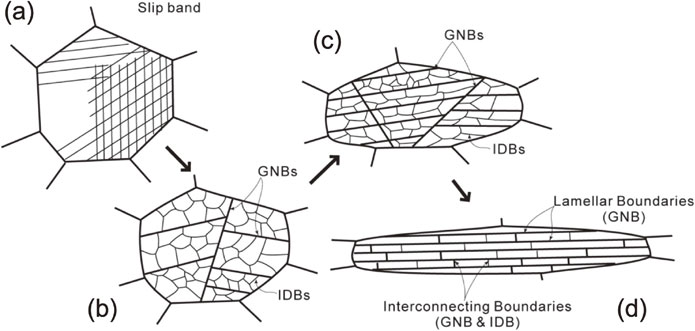
Fig. 7 Schematic illustration showing progress of the
grain subdivision in a grain within a polycrystalline material during plastic deformation.
17)
Fullsize Image
View full abstract
-
J. Čížek, M. Janeček, T. Vlasák, B. Smola, O. Melikhova, R.K. Islamgal ...
Article type: Overview
Subject area: Special Issue on Severe Plastic Deformation for Nanomaterials with Advanced Functionality
2019Volume 60Issue 8 Pages
1533-1542
Published: August 01, 2019
Released on J-STAGE: July 25, 2019
JOURNAL
FREE ACCESS
FULL-TEXT HTML
A high density of lattice defects is introduced to materials by severe plastic deformation (SPD). Numerous experimental techniques, in particular electron microscopy, X-ray, electron and neutron diffraction, etc. are employed to characterize the evolution of microstructure and defects with strain introduced to the material by SPD. These techniques concentrate mainly on the investigation of planar (grain boundaries) and line defects (dislocations). On the other hand, point defects, namely vacancies and their agglomerates are investigated in less detail. Positron annihilation spectroscopy (PAS) proved to be an effective method for the investigation of point defects and dislocations in ultra-fine grained (UFG) materials. This study summarizes the results of the investigation of lattice defects in UFG metals with fcc (Al, Ni, Cu), bcc (Fe, Nb, W) and hcp (Mg, Ti) structure prepared by high pressure torsion (HPT). Two techniques of PAS were employed (i) positron lifetime spectroscopy (LT) allowing to characterize the type and concentration ratio of lattice defects in the severely deformed material and (ii) Doppler broadening (DB) of annihilation radiation providing analysis of the homogeneity of the UFG structure and spatial distribution of defects. The latter technique was complemented by mapping of microhardness distribution throughout the surface of the HPT specimens.
The LT studies revealed that HPT straining at room temperature introduced not only dislocations but also a high concentration of vacancies. A significant fraction of deformation-induced vacancies disappeared by diffusion to sinks at grain boundaries. Remaining vacancies agglomerated into vacancy clusters. The average size of vacancy clusters differs in various metals and is affected by the activation energy for migration of vacancies in the given material.
The analysis of DB of positron annihilation radiation and its correlation with microhardness distribution indicated that dislocation density tends to saturate with strain. On the other hand, the spatial (lateral) distribution of vacancy clusters remains non-uniform even in samples subjected to a high number of HPT revolutions. The average size of vacancy clusters increases with radial distance from the centre of the sample due to the increasing production rate of vacancies.
Fig. 6 UFG Cu subjected 1, 10 and 25 HPT revolutions: colour coded map of (a), (b), (c) microhardness (HV); (d), (e), (f)
S-parameter determined from Doppler broadening of the annihilation photo-peak. The
S parameter values were normalized to the value
S0 corresponding to a well annealed Cu.
11)
Fullsize Image
View full abstract
-
Xu Yang, Hongjiang Pan, Jinxu Zhang, Hongliang Gao, Baipo Shu, Yulan G ...
Article type: Overview
Subject area: Special Issue on Severe Plastic Deformation for Nanomaterials with Advanced Functionality
2019Volume 60Issue 8 Pages
1543-1552
Published: August 01, 2019
Released on J-STAGE: July 25, 2019
JOURNAL
FREE ACCESS
FULL-TEXT HTML
It is well known that the bulk nanostructured metallic materials generally exhibit high strength but poor ductility, which greatly hinders their applications. In most cases, material failures usually start from the surface. Therefore, the surface modification is crucial to improving the mechanical properties of metallic materials. The surface mechanical attrition treatment (SMAT) is one of the most effective surface modification methods. It can be used to manufacture gradient nanostructured materials that there is no interfaces between the surface and the coarse-grained matrix. Additionally, the gradient nanostructured metallic materials fabricated by SMAT exhibit a preferable combination of strength and ductility compared with conventional homogeneous materials. It is generally believed that the high strength of the SMAT-ed metallic materials is owing to the surface fine-grain strengthening. Whereas the improved ductility can be attributed to the coarse-grained matrix and the superior work hardening ability of the gradient structured (GS) materials.
In this overview, the research progress of the GS metallic materials fabricated by SMAT is summarized. It mainly introduces the microstructure characteristics of the GS layer and the mechanical properties of GS metallic materials. Finally, in order to find the optimal match between the strength and ductility in the GS materials, the several factors affecting the mechanical properties of GS materials are summarized.
View full abstract
-
Krzysztof Bryła, Kaveh Edalati
Article type: Overview
Subject area: Special Issue on Severe Plastic Deformation for Nanomaterials with Advanced Functionality
2019Volume 60Issue 8 Pages
1553-1560
Published: August 01, 2019
Released on J-STAGE: July 25, 2019
JOURNAL
FREE ACCESS
FULL-TEXT HTML
Producing ultrafine-grained (UFG) materials by means of severe plastic deformation (SPD) methods has made a significant progress within the past few decades. The topic has been of interest since the beginning of the last century at least, yet the historical studies on this subject are less-known in the SPD society. In this manuscript, the studies of the Polish scientist Stanisław Erbel including his book entitled “Mechanism of Change of Properties of Metals Subjected to Large Deformations” written in 1976 are reviewed. Although American physicist Percy W. Bridgman published a book earlier on the principles of SPD in 1952, Erbel’s book is probably the first book dedicated to the formation of UFG materials by SPD processing. In this book, Erbel presented details of a high-pressure torsion (HPT) device for obtaining large strains, mechanism of microstructural fragmentation during large straining, evolution of mechanical properties (hardness, tensile properties and torque), and characterization of the microstructure by means of transmission electron microscopy (TEM). The TEM studies included not only ex-situ observations but also in-situ observations to examine the dislocation motion and thermal stability.

View full abstract
-
D.R. Leiva, A.M. Jorge, Jr., T.T. Ishikawa, W.J. Botta
Article type: Review
Subject area: Special Issue on Severe Plastic Deformation for Nanomaterials with Advanced Functionality
2019Volume 60Issue 8 Pages
1561-1570
Published: August 01, 2019
Released on J-STAGE: July 25, 2019
JOURNAL
FREE ACCESS
FULL-TEXT HTML
Mg-based hydrides have been extensively studied in the last 20 years due to its great potential as hydrogen storage materials, especially for stationary applications. Severe plastic deformation (SPD) can be used to produce Mg-based materials for hydrogen storage applications, with good activation (first hydrogenation) and H-absorption/desorption kinetics, combined with enhanced air resistance. Both advanced (e.g. high-pressure torsion, equal-channel angular pressing) and more conventional (e.g. cold rolling, cold forging) techniques were investigated as means of production of bulk samples with refined microstructures and controlled textures. Depending on the processing parameters, SPD or SPD-like techniques can produce sub-microcrystalline or even nanocrystalline structures, with a fair level of dispersion of the additives and high level of the desired [0002] fibre type texture. In this review we discuss how the processing of hydrogen storage materials by SPD techniques matches the following desirable aspects: fast kinetics (many interfaces – nano-grains and additives), easy activation (clean surfaces, interfaces, and adequate texture) and thermodynamic stability (alloying; synergy between phases in composites). The results suggest new and in most cases simpler and cheaper alternatives to produce hydrogen storage materials with proper hydrogen absorption and desorption kinetics and, in the case of composites, lower hydride stability.

View full abstract
-
Jacques Huot, Manuel Tousignant
Article type: Review
Subject area: Special Issue on Severe Plastic Deformation for Nanomaterials with Advanced Functionality
2019Volume 60Issue 8 Pages
1571-1576
Published: August 01, 2019
Released on J-STAGE: July 25, 2019
JOURNAL
FREE ACCESS
FULL-TEXT HTML
In this paper we review the recent studies of the effect of cold rolling on selected metal hydride systems. Magnesium is the most studied element in this perspective either as pure element, alloys, allied with iron or in a composite with AB5 alloy alloys. Other systems will also be discussed such as titanium, AB5 and AB2 systems. After a critical review of these systems, we will discuss in detail the effect of cold rolling on Mg2Ni alloy and shows that cold rolling is efficient to improve the first hydrogenation but has basically no impact of subsequent hydrogenation kinetics.
Fig. 5 First hydrogenation kinetics, at 350°C under 2000 kPa of hydrogen, of Mg
2Ni alloy in the as-received state and after cold rolling.
Fullsize Image
View full abstract
-
Minxia Shi, Habibur Rehman, Aici Qiu, Junhao Li
Article type: Regular Article
2019Volume 60Issue 8 Pages
1577-1582
Published: August 01, 2019
Released on J-STAGE: July 25, 2019
Advance online publication: June 21, 2019
JOURNAL
FREE ACCESS
FULL-TEXT HTML
This paper enhances the Enokizono and Soda (E&S) two dimensional rotating magnetic properties model by integrating the impact of DC-biased field in the E&S model. An experimental set up is developed to apply the DC voltage excitation superimposed on a constant AC excitation, and to investigate their collective impact on the testing sample of electrical steel sheet. The magnetic properties B and H of the testing sample are measured under the influence of rotating and DC-biased magnetic fields. Based on the measurement results of B and H, the E&S model is enhanced by adding rotating reluctivity coefficient (vrk), rotating hysteresis coefficient (vhk), and DC reluctivity coefficient (v0k) to integrate the effect of DC-biased field with rotating magnetic field. Rotating and DC reluctivity coefficients in conjunction with rotating hysteresis coefficient are obtained by Fourier series expansion of experimental B and H waveforms. The accuracy of an enhanced model under DC-biased field is proved by the close agreement between experimental hysteresis loops of electrical steel sheet and the ones obtained by the proposed model.

Fig. 7 Integrated model coefficients extraction and verification procedure.
Fullsize Image
View full abstract
-
Tomoki Eda, Anak Khantachawana, Junko Umeda, Katsuyoshi Kondoh
Article type: Regular Article
2019Volume 60Issue 8 Pages
1583-1590
Published: August 01, 2019
Released on J-STAGE: July 25, 2019
Advance online publication: June 07, 2019
JOURNAL
FREE ACCESS
FULL-TEXT HTML
In order to improve the controllability of the mechanical properties of powder metallurgy (PM) titanium (Ti)-nickel (Ni) super-elastic alloys, cobalt (Co) powder was added to the alloys up to 2.0 at%. In particular, the dependence of plateau stress and recovery rate in tensile hysteresis test on cobalt content was investigated by considering microstructures analysis results. XRD and TEM-EDS analysis clarified cobalt elements existed as substitutional solution atoms in Ni atom sites of Ti–Ni alloys. It was confirmed that PM Ti–Ni–Co alloys with the cobalt content of 1.0 at% Co or less showed a high shape recovery rate of around 90% or more. In addition, the increment of the plateau stress of Ti–Ni–Co alloys was almost constant regardless of the holding time in heat treatment. That is, the cobalt solution content had no effect on the amount and size of Ti3Ni4 precipitates. Therefore, it was possible to independently control the plateau stress without affecting the critical slip strain by adding cobalt element to Ti–Ni alloys.
This Paper was Originally Published in Japanese in J. Jpn. Soc. Powder Powder Metallurgy 66 (2019) 9–16.
View full abstract
-
Takaya Nakamura, Kaoru Sato, Masayasu Nagoshi, Kenji Ogata, Yasuko Kit ...
Article type: Regular Article
2019Volume 60Issue 8 Pages
1591-1597
Published: August 01, 2019
Released on J-STAGE: July 25, 2019
Advance online publication: June 21, 2019
JOURNAL
FREE ACCESS
FULL-TEXT HTML
Precise characterization of fine precipitates in steels is crucial owing to the influence of these precipitates on the mechanical properties. Various types of carbide precipitates occur in heat-resistant Cr–Mo steels. Their identification typically requires characteristic X-ray and diffraction analysis because it is usually not possible to differentiate carbides based solely on their size and morphology. Modern scanning electron microscopes equipped with multiple image detectors can provide abundant microstructural information. Thus, we investigated the use of secondary electron (SE) and backscattered electron (BSE) image contrast to determine the types of precipitates in the commonly used 2.25Cr–1Mo steel. A mechanically polished bulk specimen was examined and the observation parameters were optimized by systematically varying the SEM accelerating voltage and working distance. We found that the use of a low accelerating voltage and short working distance enabled the differentiation of four types of carbides and AlN precipitate in the steel specimen. A small penetration depth of the primary electrons and selective acquisition of SE/BSE were the key to extracting the material contrast. This technique is expected to allow quantification of the size, distribution, and area fraction of precipitates over large areas of bulk specimens.
This Paper was Originally Published in Japanese in J. Japan Inst. Met. Mater. 82 (2018) 169–175. Refinements of English were made for the title of the paper, the abstract, and the captions of Fig. 6, Fig. 7, and Table 2. The Ref. 24) was newly added.
Fig. 7 (a) In-lens SE image of the 2.25Cr–1Mo steel specimen obtained using an accelerating voltage of 1 kV and a WD of 5 mm. (b) Multilevel thresholding image of (a).
Fullsize Image
View full abstract
-
Kosuke Hayashi, Masayuki Tsushida, Hiromoto Kitahara, Shinji Ando
Article type: Regular Article
2019Volume 60Issue 8 Pages
1598-1600
Published: August 01, 2019
Released on J-STAGE: July 25, 2019
Advance online publication: July 05, 2019
JOURNAL
FREE ACCESS
FULL-TEXT HTML
Cerium, a rare earth element, was alloyed at various ratios with magnesium to create Mg–Ce single crystals which were then subjected to [1100] and [1120] tensile tests to clarify effects of cerium on activation of non-basal slips at room temperature. Mg–0.016 mol%Ce alloys yielded due to {1011} twins in [1100] tension tests. Mg–0.052 mol%Ce single crystals yielded due to {1122}⟨1123⟩ second order pyramidal ⟨c+a⟩ slip (SPCS), similar to pure magnesium single crystals, in [1120] tensile tests. Cerium addition decreased critical resolved shear stresses (CRSS) for {1011} twinning and SPCS. The decrease in CRSS for SPCS likely results from the frequency of sessile (c+a) dislocations decreasing with decreasing stacking fault energy of second order pyramidal planes.
This Paper was Originally Published in J. Japan Inst. Light Metals 69 (2019) 125–127.
View full abstract
-
Kento Inokuchi, Masayuki Tsushida, Hiromoto Kitahara, Shinji Ando
Article type: Regular Article
2019Volume 60Issue 8 Pages
1601-1604
Published: August 01, 2019
Released on J-STAGE: July 25, 2019
Advance online publication: July 05, 2019
JOURNAL
FREE ACCESS
FULL-TEXT HTML
Single crystalline thin sheets of pure Mg and two alloys containing cerium — 0.016 mol% Ce and 0.028 mol% Ce — were subjected to plane bending fatigue tests so as to clarify effects of cerium addition on fatigue fracture behavior of magnesium. Both fatigue limit and fatigue life were found to improve by cerium addition. With increasing cerium concentration, fatigue crack initiation lives shorten, while crack propagation rates decrease. Critical resolved shear stress for second order pyramidal slip decreased by cerium addition, resulting in short fatigue crack initiation lives.
This Paper was Originally Published in J. Japan Inst. Light Metals 69 (2019) 128–130.
View full abstract
-
Alexis Chino-Ulloa, Mario Hernandes-Alejandro, José L. Castrejón-Flore ...
Article type: Regular Article
2019Volume 60Issue 8 Pages
1605-1613
Published: August 01, 2019
Released on J-STAGE: July 25, 2019
Advance online publication: May 31, 2019
JOURNAL
FREE ACCESS
FULL-TEXT HTML
This study evaluates the effect of a self-lubricant film with ultra-low friction coefficient on the biocompatibility of the AISI 316L. The samples were thermochemically treated to generate a hard surface layer of iron borides followed by a secondary process. The purpose of the secondary process was to generate a self-lubricant film of boric acid. The ultra-low friction coefficient of boric acid films was estimated in 0.02 compared to 0.2 and 0.8 for borided and as-received AISI 316L steel respectively. The effect of the boric acid films on the steel’s biocompatibility was evaluated by the culture of Madin-Darby canine kidney II (MDCK II) cells with exposure times of 0, 4, 8, 12, 24, 48 and 72 h. The In vitro tests revealed the absence of cytotoxic effect by the direct exposure of the cells to the samples. Additionally, the presence of signs early apoptosis by the determination of the expression of the cysteinyl proteases termed caspase-3 and -9 was determined. Their presence was assessed by indirect immunofluorescence in cells in direct contact with the samples. No significant expression of the proteolytic enzymes was detected. All these results suggest that the surface film of boric acid does not induce any cytotoxic effect and does not inhibit the cell-cell adhesion.

View full abstract
-
Hye-Jin Kim, Hyun-Yeong Jung, Tae-Woo Kwon, Yoo-Dong Chung
Article type: Regular Article
2019Volume 60Issue 8 Pages
1614-1623
Published: August 01, 2019
Released on J-STAGE: July 25, 2019
Advance online publication: June 21, 2019
JOURNAL
FREE ACCESS
FULL-TEXT HTML
This study investigates the effect of plastic deformation on hydrogen permeation behavior of martensitic steel using electrochemical hydrogen permeation methods. The values of hydrogen diffusivity in plastically deformed martensitic steel were investigated from a microstructural aspect. Additionally, thermal desorption spectroscopy was performed to verify the tendency of plastic deformation due to hydrogen trapping. It was observed that as the plastic strain applied on the martensitic steel increased, value of hydrogen diffusion coefficient decreased and hydrogen concentration increased. The decrease in hydrogen diffusion coefficient and an increase in hydrogen trapping in the plastically deformed martensitic steel were attributed to an increase in reversible trapping sites caused by strain-induced dislocations.

Fig. 6 Results of hydrogen permeation test on the martensitic steels with various pre-strain values in the 0.5 M H
2SO
4 + 0.25 g/L NH
4CSN solution at room temperature: (a) hydrogen permeation current density and (b) normalized flux.
Fullsize Image
View full abstract
-
Satoko Kuwano-Nakatani, Joji Fujiwara, Yuta Fujimoto, Yuma Hosoya, Kaz ...
Article type: Regular Article
2019Volume 60Issue 8 Pages
1624-1628
Published: August 01, 2019
Released on J-STAGE: July 25, 2019
Advance online publication: June 07, 2019
JOURNAL
FREE ACCESS
FULL-TEXT HTML
Nano-scale noble metallic materials exhibit catalytic activity and can serve as photocatalytic cocatalysts. The effectiveness of nanoporous gold (NPG) as a cocatalyst on TiO2 depends on NPG pore size and composition. Suitably sized pores ensure that NPG can exhibit surface plasmon resonance, which enhances the photocatalytic activity of TiO2 for hydroxyl (OH) radical generation. Moreover, Ag on NPG serves as generation sites for reactive oxygen species, because O2 can be decomposed to atomic oxygen. Owing to these factors, NPG could serve as a high-performance cocatalyst for TiO2. In this study, we utilized the porous property of NPG to fabricate a nanocomposite material of TiO2 and NPG (TiO2/NPG) without annealing or complicated processing. Moreover, we evaluated the photocatalytic activity of the TiO2/NPG composite by measuring the amount of generated OH radicals. Our results suggest that NPG promoted the generation of OH radicals and that the amount of OH radicals increased with particular pore sizes of NPG and amounts of Ag.

Fig. 1 Plane-view SEM images of the NPG surface with pore sizes of (a) 10 nm, (b) 20 nm, (c) 30 nm, (d) 40 nm, and (e) 50 nm, and (f) NPG with TiO
2.
Fullsize Image
View full abstract
-
Yuting Lv, Bingjie Zhao, Hongbin Zhang, Chunjian Su, Bin Nie, Rui Wang ...
Article type: Regular Article
2019Volume 60Issue 8 Pages
1629-1637
Published: August 01, 2019
Released on J-STAGE: July 25, 2019
Advance online publication: June 07, 2019
JOURNAL
FREE ACCESS
FULL-TEXT HTML
In this paper, Nickel-Aluminum Bronze (NAB) alloy was subjected to the shot-peening (SP) treatment, and the corrosion resistance properties of SPed NAB alloy was systematically studied by scanning electron microscope, transmission electron microscopy, electrochemical workstation and immersion tests. The results show that SP treatment can improve the corrosion resistance properties of NAB alloy by controlling shot peening intensity. The SP treatment can result in rough surfaces, high-density dislocations and grain refinement of α and β′ martensitic phases in NAB alloy surface. In the corrosion medium, the corrosion resistance properties of SPed NAB alloys are related to not only the surface microstructures but also the surface roughness. The refined and homogenized microstructures favors the rapid formation of the protective passive film and promotes the occurrence of uniform corrosion on shot-peened NAB alloy surface, thus significantly improving their corrosion resistance properties. However, as the shot-peening intensity exceeds a critical value, the higher roughness values due to the large cracks, chips and flaking appearing on the shot-peened sample surface can deteriorate corrosion resistance properties.
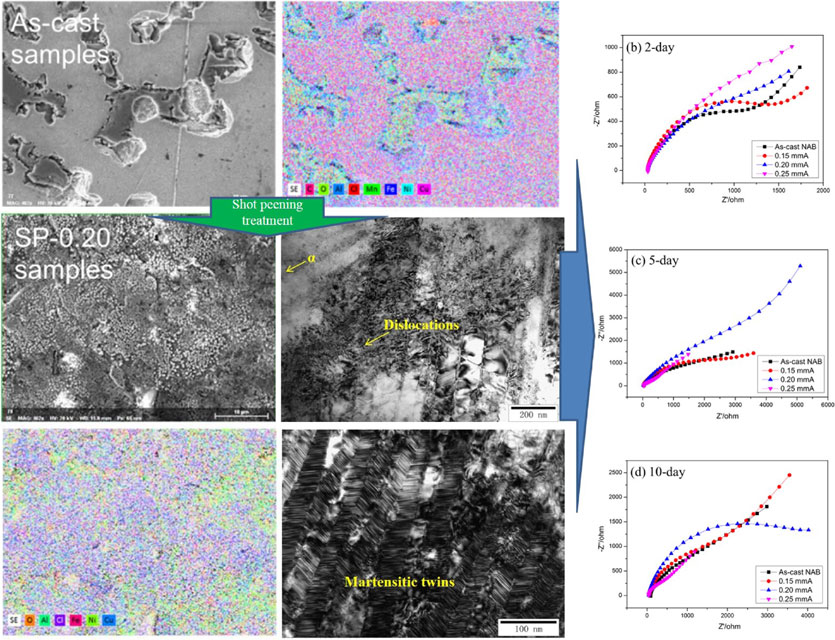
View full abstract
-
Yasuhiro Hoshiyama, Rei Takatera, Tomoki Maruoka
Article type: Regular Article
2019Volume 60Issue 8 Pages
1638-1642
Published: August 01, 2019
Released on J-STAGE: July 25, 2019
Advance online publication: June 14, 2019
JOURNAL
FREE ACCESS
FULL-TEXT HTML
In the active screen plasma nitriding (ASPN) method, the material to be processed is insulated. A mesh-like metal screen is placed around the material to be used as the cathode and a furnace wall is used as the anode. In this study, the effect of ASPN treatment on the fatigue characteristics of austenitic stainless steel was investigated. Nitride layers of varying thicknesses were formed by varying the treatment time to energize the treated material without insulation. A direct-current plasma nitriding apparatus was used for active screen plasma nitriding treatment. The nitriding treatment was performed at an N2:H2 concentration ratio of 1:1 for 28.8–172.8 ks at 673 K and 100 Pa. The thickness of the nitride layer increased as the treatment time increased. The fatigue strength increased as a result of the ASPN treatment. Furthermore, the fatigue strength increased as the thickness of the nitride layer increased.

Fig. 7 Rotating bending fatigue tests performed on ASPN-treated round bar samples.
Fullsize Image
View full abstract
-
Tomoo Goda, Shinji Kumai
Article type: Regular Article
2019Volume 60Issue 8 Pages
1643-1650
Published: August 01, 2019
Released on J-STAGE: July 25, 2019
JOURNAL
FREE ACCESS
FULL-TEXT HTML
Al–7%Si–0.4%Mg alloy was cast using a vertical-type high-speed twin-roll caster equipped with commercial scale large rolls. The cast strip had a distinct cross-hatched surface pattern on both sides, with matte and glossy regions periodically distributed throughout the surface. Surface characterization revealed that the difference in appearance making up the pattern was correlated with the difference in surface profile, roughness, and microstructure of the outermost surface. In addition, the pattern was in harmony with the discontinuous distribution of the center segregation band. An interrupted casting confirmed that the cross-hatched surface patterns started forming at the site where solidified shells contacted with each other and strip was deformed by the roll separating force. Therefore, a mechanism is proposed to explain that the squeezing of liquid from mushy layer in a cyclic manner forms the cross-hatched pattern, which corresponds to the periodic distribution of eutectic-rich and α-Al-rich regions in the mid-thickness of the strip.
View full abstract
-
Jun Yaokawa, Yusuke Yagi, Yoshio Sugiyama, Shuxin Dong, Yasushi Iwata
Article type: Regular Article
2019Volume 60Issue 8 Pages
1651-1658
Published: August 01, 2019
Released on J-STAGE: July 25, 2019
Advance online publication: June 07, 2019
JOURNAL
FREE ACCESS
FULL-TEXT HTML
Solid solution elements in the α-Al phase affect the dimensional precisions under high temperature circumstances and the mechanical properties of Al–Si alloy castings. However, there is insufficient information on the concentration of the solid solution elements in as-cast castings. In this study, we examined the possibility of estimating the concentration of the solid solution silicon in the α-Al phases of permanent mold cast Al–Si alloy castings using a theoretical model related to the concentration of the solid solution silicon and the dimensional change arising from heat treatment. Al–1%Si and Al–10%Si alloy castings containing 1.00% and 1.06% solid solution silicon in the α-Al phases, respectively, were prepared for the examination by solution treatment at 805 K for 3.3 hours after casting. By comparing the experiment and the theoretical dimensional changes of the specimens, it was verified that the theoretical model can be used for calculating the concentration of solid solution silicon in the α-Al of castings. The average concentrations of the solid solution silicon in the α-Al phases of as-cast Al–1%Si and Al–10%Si alloy specimens were also estimated as 0.81% and 0.73% respectively from the dimensional changes of the castings due to the heat-treatment at 743 K, 713 K and 473 K by the theoretical model.
This Paper was Originally Published in Japanese in J. JFS 90 (2018) 130–137.
View full abstract
-
Yosuke Tamura, Kentaro Mizuno, Kenzo Takahashi
Article type: Regular Article
2019Volume 60Issue 8 Pages
1659-1665
Published: August 01, 2019
Released on J-STAGE: July 25, 2019
JOURNAL
FREE ACCESS
FULL-TEXT HTML
In this study, the electromagnetic separation behavior of primary Al13Fe4 crystallized in the cooling process of molten Al–10 mass%Fe alloy was clarified by observation of the solidification structure. The electromagnetic force was controlled by keeping the magnetic flux density constant and changing the applied direct current. The applied current was set in the range of 0 A to 100 A, and the experiment was conducted at intervals of 20 A to investigate the electromagnetic separation behavior of primary Al13Fe4.
During the cooling process, no separation effects of primary Al13Fe4 were observed, even when a current or magnetic field was independently applied. When both current and a magnetic field were applied, primary Al13Fe4 was miniaturized by the electromagnetic force and distributed in the surface layer of the ingot. However, no eutectic Al13Fe4 separation effect was observed. Even when the direction of the magnetic field was changed, primary Al13Fe4 was similarly distributed in the surface layer of the ingot. Electromagnetic separation effects were observed even in the range beyond the magnetic poles. When the length of the specimen was shortened to be within the range of the permanent magnet, no change was observed in the distribution behavior of primary Al13Fe4 in the surface layer of the ingot. During the cooling process, a negative pressure gradient was assumed to be formed from the specimen axis toward the surface, regardless of the direction of the electromagnetic force.
This Paper was Originally Published in Japanese in J. JFS 90 (2018) 508–514.
View full abstract
-
Akira Takeuchi, Takeshi Wada, Hidemi Kato
Article type: Regular Article
2019Volume 60Issue 8 Pages
1666-1673
Published: August 01, 2019
Released on J-STAGE: July 25, 2019
Advance online publication: June 07, 2019
JOURNAL
FREE ACCESS
FULL-TEXT HTML
High-entropy alloys (HEAs) with a single hexagonal close-packed (hcp) structure were found in Ir26Mo20Rh22.5Ru20W11.5 and Ir25.5Mo20Rh20Ru25W9.5 alloys annealed at 2373 K for 1 h. These HEAs were designed based on a sandwich strategy for valence electron concentration (VEC) of the constituent elements and by referring to their crystallographic structures in the periodic chart. The initial component and composition of these alloys were determined by considering exact and near equiatomic sub binary phase diagrams, followed by optimizing the composition by Thermo-Calc with the TCHEA3 database for HEAs as well as the SSOL5 database for solid solutions. The X-ray diffraction analysis, scanning electron microscopy observation, and energy-dispersive X-ray spectroscopy analysis revealed that the Ir26Mo20Rh22.5Ru20W11.5 and Ir25.5Mo20Rh20Ru25W9.5 alloys annealed at 2373 K for 1 h were formed in an hcp single phase. The formation of the hcp structure was principally evaluated by the VEC values of 7.855 and 7.865 for Ir26Mo20Rh22.5Ru20W11.5 and Ir25.5Mo20Rh20Ru25W9.5 alloys, respectively, such that these values were close to VEC = 8 for pure elements Ru and Os with an hcp structure. It is considered that Ru is a strong hcp-forming element under this strategy because the other pure constituent elements have different crystallographic structures. The formation of Ir26Mo20Rh22.5Ru20W11.5 and Ir25.5Mo20Rh20Ru25W9.5 HEAs with an hcp structure is unique because these alloys, which consist of only transition metals, can be produced without applying high pressure, similar to a CrMnFeCoNi HEA with an hcp structure.
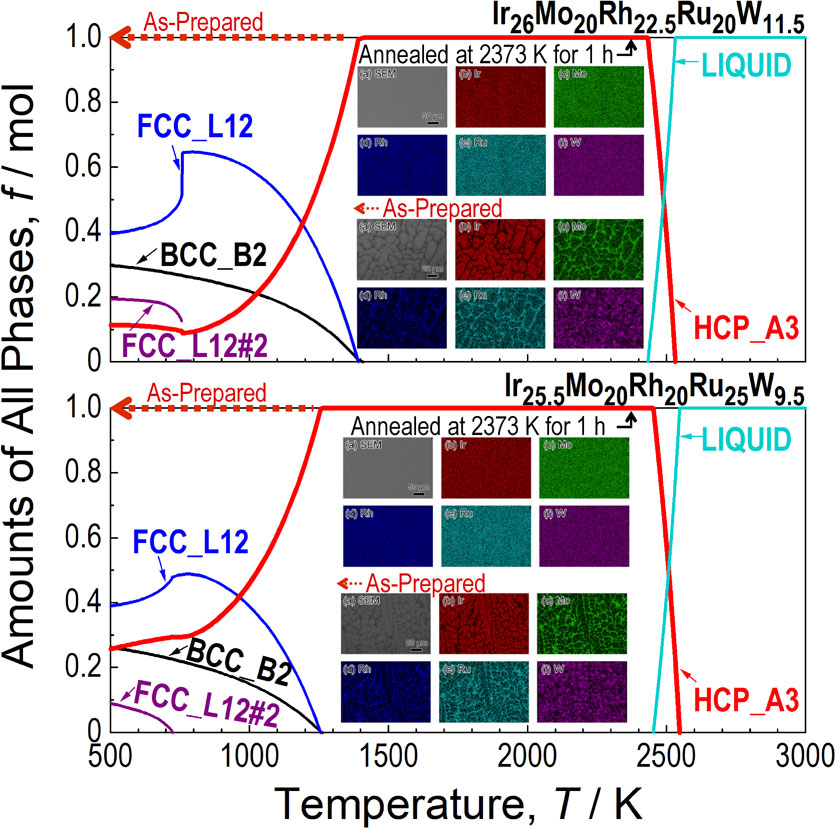
Property diagram calculated with Thermo-Calc 2018b and TCHEA3 database for (top) Ir
26Mo
20Rh
22.5Ru
20W
11.5 and (bottom) Ir
25.5Mo
20Rh
20Ru
25W
9.5 alloys, where inserts are (a) SEM image and (b–f) element-mapping images of the alloys annealed at 2373 K for 1 h and as-prepared samples.
Fullsize Image
View full abstract
-
Jing Yang, Yonggang Xu, Song Zhang, Mingyue Zhang
Article type: Regular Article
2019Volume 60Issue 8 Pages
1674-1679
Published: August 01, 2019
Released on J-STAGE: July 25, 2019
JOURNAL
FREE ACCESS
FULL-TEXT HTML
In this paper, brazing of Mn–Cu damping alloy and 430 stainless steel (SS) using Cu–34Mn–6Ni–10Sn filler metal was carried out at different temperatures (850 °C to 880 °C) for different times (5 min to 12 min). The microstructure and mechanical properties of brazed joints were investigated. The results show that a (Fe, Mn) solid solution diffusion layer was formed at the interface between SS and brazing seam. The brazing seam was composed of a (Cu, Mn) solid solution phase and a (Cu, Mn, Sn) solid solution phase. Besides, the needle-like Mn–Cr–Cu–Fe compounds were found to distribute near the interface of each substrate and brazing seam. The grain boundary penetration of (Cu, Mn, Sn) solid solution phase led to the local melting of Mn–Cu alloy. The joint brazed at 870 °C for 10 min possessed the highest shear strength of about 212 MPa, the fracture occurred at the middle of brazing seam.
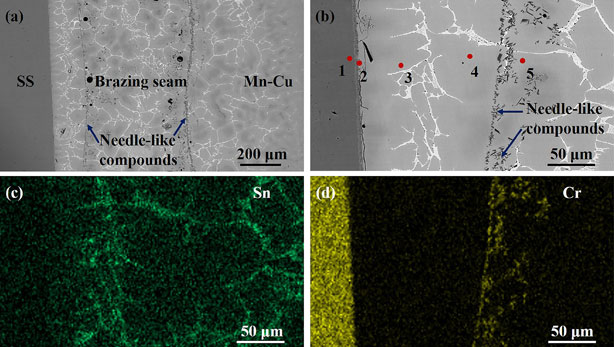
Fig. 4 BSE images of the microstructure of (a) Mn–Cu/SS joint brazed at 870 °C for 10 min and (b) the interface region of SS/brazing seam, surface scan of Sn (c) and Cr (d) of (b).
Fullsize Image
View full abstract
-
Tomoyasu Obata, Yongpeng Tang, Hideaki Iwaoka, Shoichi Hirosawa, Keiki ...
Article type: Regular Article
2019Volume 60Issue 8 Pages
1680-1687
Published: August 01, 2019
Released on J-STAGE: July 25, 2019
Advance online publication: June 07, 2019
JOURNAL
FREE ACCESS
FULL-TEXT HTML
At present, the strength of most of Al–Mg–Si alloy bolts is not enough, and thus highly expected to be increased, for example, to >500 MPa in ultimate tensile strength (UTS). In this study, mechanical strength of A6056 Al–Mg–Si alloy was aimed at improving, without diminishing the elongation, by combined application of equal-channel angular pressing (ECAP) and various aging treatments. Multi-pass ECAP and pre-aging (PA) treatment at 373 K for 1.2 ks was found to be effective in strengthening the bolt material subject to room-temperature storage followed by artificial aging. Especially, PA plus ECAP 2pass treatment exerted the biggest impact on the strength (i.e. 514 MPa in UTS) with a reasonable elongation to fracture (i.e. 16%). Such a high strength and good ductility exceeds minimum requirement for aluminum-made bolts registered in JIS B1057, and thus the developed PA-ECAP 2pass specimen can be utilized potentially as a high-strength bolt material.
This Paper was Originally Published in Japanese in J. JILM 68 (2018) 65–72.
View full abstract
-
Kenji Matsuda, Toru Yasumoto, Artenis Bendo, Taiki Tsuchiya, Seungwon ...
Article type: Regular Article
2019Volume 60Issue 8 Pages
1688-1696
Published: August 01, 2019
Released on J-STAGE: July 25, 2019
Advance online publication: June 07, 2019
JOURNAL
FREE ACCESS
FULL-TEXT HTML
The effect of Cu-addition on age-hardening and precipitation have been investigated by hardness measurement, tensile test, high resolution transmission electron microscopy (HRTEM) and high angle annular dark field scanning transmission electron microscopy (HAADF-STEM) techniques. Higher hardness, strength, and lower elongation were caused by increasing amount of Zn + Mg because of increased number density of precipitates. Cu addition also provided even higher peak hardness, strength, and lower elongation. The alloy containing highest Cu content had fine precipitates of GPB-II zones or the second clusters, in the precipitate free zones (PFZs) and the matrix, together with η′/η in the matrix from the early stage of aging. Two regions have been confirmed as the PFZs in the peak aged alloy containing highest Cu: (i) nearest to grain boundary (GB) about 70 nm in width (n-PFZ) and (ii) conventional PFZ about 400 nm in width which can be confirmed by conventional TEM (con-PFZ). The con-PFZ contains fine precipitates consisting of GPB-II zones or the second clusters, even for 2 minutes of aging at 473 K which were not present in the n-PFZ. The fine precipitates, GPB-II zones or the second clusters in the con-PFZ and the matrix disappeared at overaged condition.
View full abstract
-
Tomoko Kuno, Shunji Suzuki, Kimiko Urushibata, Kurima Kobayashi, Satos ...
Article type: Regular Article
2019Volume 60Issue 8 Pages
1697-1706
Published: August 01, 2019
Released on J-STAGE: July 25, 2019
JOURNAL
FREE ACCESS
FULL-TEXT HTML
We newly prepared the ThMn12 compounds (Sm0.9Zr0.1)(Fe0.8Co0.2)11.3Ti0.7 (A) and (Nd0.8Zr0.2)(Fe0.9Co0.1)11.3Ti0.7N1.5 (B), which were almost α-(Fe,Co) phase-free. These compounds show magnetic properties superior to those of the Nd2Fe14B phase in the high-temperature region (473 K). We also prepared a typical α-(Fe,Co) phase-free compound, Nd(Fe0.8Co0.2)11MoN1.3 (C), which has a low saturation polarization, but a high magnetic anisotropy field, and better thermal stability. We examined the effect of pulverization on the coercivity (Hc) of compounds (A)–(C). The critical radii of single-domain particles (Rc) were about 120 nm for (A) and (B), and about 400 nm for (C), and were determined from the measured magnetic domain widths of the most coercive pulverized particles of each sample. As the pulverization time increased, Hc increased to maximum values of 0.10 MAm−1 for (A), 0.14 MAm−1 for nitrogenated (B), and 0.21 MAm−1 for nitrogenated (C). Further pulverization of the samples decreased Hc. The decrease was mainly caused by oxidation in non-nitrogenated (A) and by the accumulation of lattice distortion in (B) and (C).
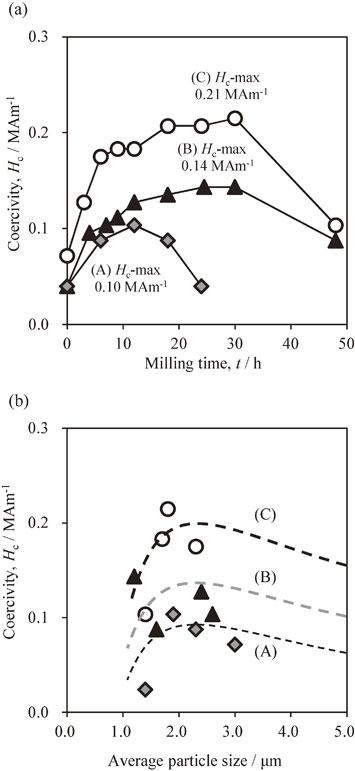
Fig. 6 Variation of
Hc with milling time (0–48 h) (a) and variation of
Hc with particle size (b).
Fullsize Image
View full abstract
-
Patrícia S. Sato, Toshiki Watanabe, Hirotaka Maeda, Akiko Obata, Toshi ...
Article type: Regular Article
2019Volume 60Issue 8 Pages
1707-1710
Published: August 01, 2019
Released on J-STAGE: July 25, 2019
Advance online publication: May 24, 2019
JOURNAL
FREE ACCESS
FULL-TEXT HTML
The 65ZnO–30P2O5–5Nb2O5 (ZnPNbO) glass is one of the promising candidate antibacterial biomaterials; it is a safe material since the release of Zn2+ ions from the glass is well-controlled. To discuss the origin of this controlled release from the view point of its glass structure, the amount and state of bridging oxygen in the glass was examined using X-ray photoelectron spectroscopy, and compared with those in 65CaO–30P2O5–5Nb2O5 (CaPNbO) glass. The number of P–O–P bonds in ZnPNbO glass was larger and that of P–O–Nb bonds was smaller than those in CaPNbO glass. This was linked with the formation of a large number of P–O–Zn bonds. The outermost shell electron density of the cations in ZnPNbO glass decreased, and as a result, the binding energy of each element increased. These might be closely related to the controlled release of Zn2+ ions.
View full abstract
-
Soichiro Deguchi, Masataka Hakamada, Mamoru Mabuchi
Article type: Regular Article
2019Volume 60Issue 8 Pages
1711-1715
Published: August 01, 2019
Released on J-STAGE: July 25, 2019
Advance online publication: May 31, 2019
JOURNAL
FREE ACCESS
FULL-TEXT HTML
To date, many studies have been performed on interactions between amino acids and inorganic surfaces. However, the interactions are still in debate. Au is one of important biometals with inertness and subsequent biocompatibility in a living body. Because amino acids tend to adsorb on Au surface, it is required to investigate interactions between amino acids and Au surface for safe application of Au. In the present work, adsorption of RGD (arginine-glycine-aspartic acid, Arg-Gly-Asp) sequence on Au (111) surface is investigated by first principles calculations. When two oxygen atoms of carboxyl group in Asp were located very close to the atop sites of the Au surface, RGD was the most stable on the Au surface, like the adsorption of a single molecule of Asp on the Au surface. The adsorption energy of RGD on the Au surface was lower than that of Asp on the Au surface. This is because the negative hyperpolarization of Asp side chain and the positive hyperpolarization of Arg side chain are enhanced by the RGD sequence.

Fig. 1 (a) A schematic illustration of adsorption sites (atop, fcc, hcp and bridge sites) of Au (111) surface and (b) the RGD-Au (111) model. In (a), yellow, green and magenta spheres indicate Au atoms of the first (111) lay, the second (111) lay and the third (111) lay, respectively. In (b), yellow, red, blue and white spheres indicate gold, oxygen, carbon and hydrogen atoms, respectively.
Fullsize Image
View full abstract
-
Xiaojia Zhao, Chaoqun Li
Article type: Regular Article
2019Volume 60Issue 8 Pages
1716-1721
Published: August 01, 2019
Released on J-STAGE: July 25, 2019
JOURNAL
FREE ACCESS
FULL-TEXT HTML
Poly(Vinylidene fluoride-hexafluoropropylene) [P(VDF-HFP)] nanocomposites filled with multiwalled carbon nanotubes (MWCNTs) were successfully fabricated by solution casting. The influence of MWCNTs on the phase structure, dielectric and mechanical properties of MWCNTs/P(VDF-HFP) nanocomposites were evaluated. FTIR spectra and X-ray diffraction show that the incorporation of MWNTs promoted the formation of γ phase crystal. The DSC curves demonstrated that the nanocomposites possess higher Tm and Tc than neat P(VDF-HFP), which can be explained by the increasing of the γ phase crystal and the heterogeneous nucleation effect respectively. In addition, the dielectric constant of the nanocomposites is enhanced remarkably with the increasing content of the MWNTs. The highest dielectric constant of the MWCNTs/P(VDF-HFP) nanocomposites was about 106 when the content of fillers was 1.3 vol% at 1 kHz. The percolation threshold of the nanocomposites was predicted at about 1.2 vol%. Moreover, The tensile strength and Young’s modulus of 1.2 vol% MWCNTs/P(VDF-HFP) nanocomposites reach to maximum.
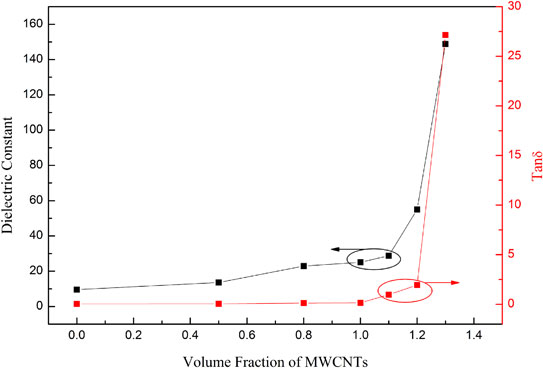
Fig. 5 Dependence of dielectric constant and dielectric loss (tan δ) of composites on contents of MWCNTs measured at 1 kHz and room temperature.
Fullsize Image
View full abstract


